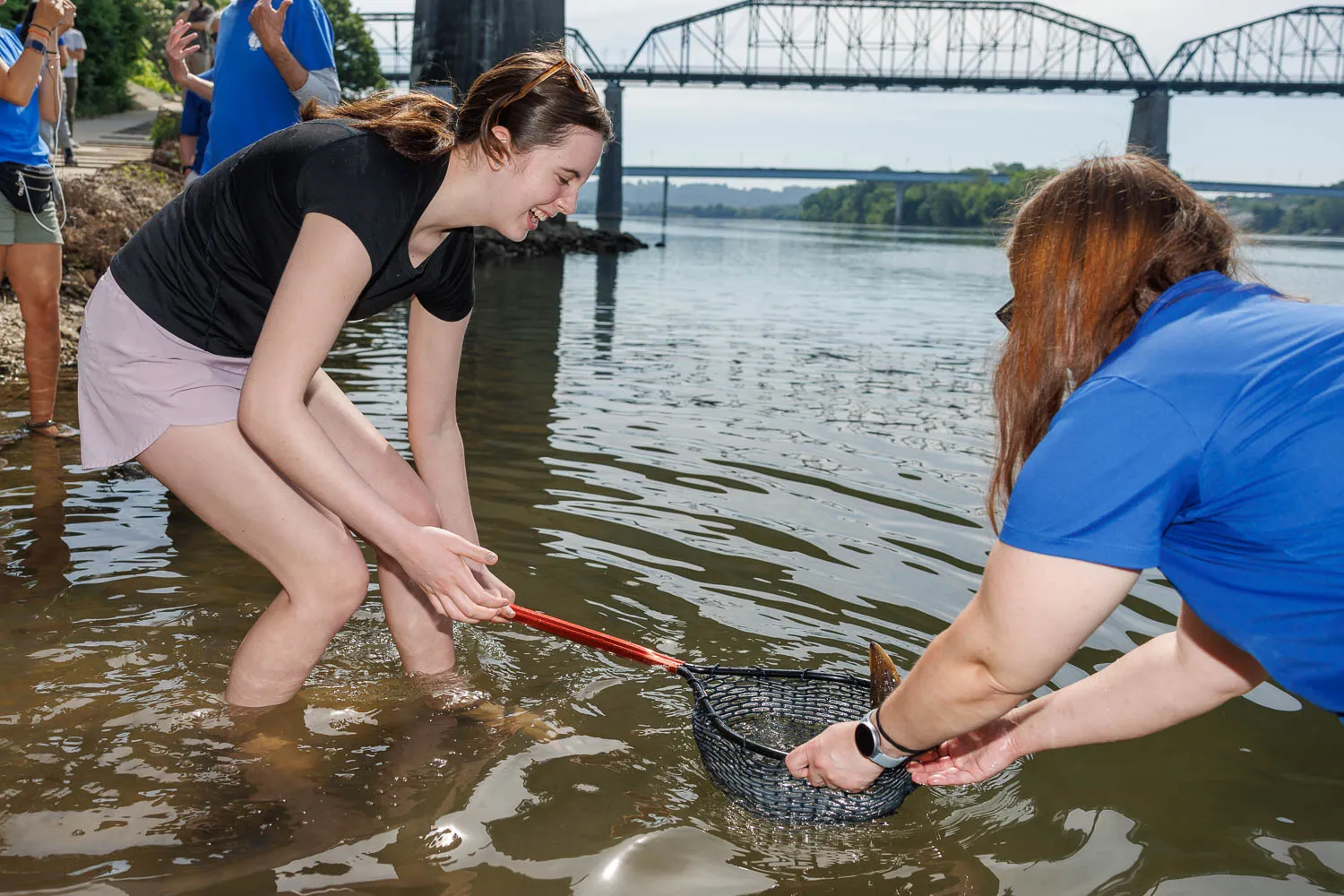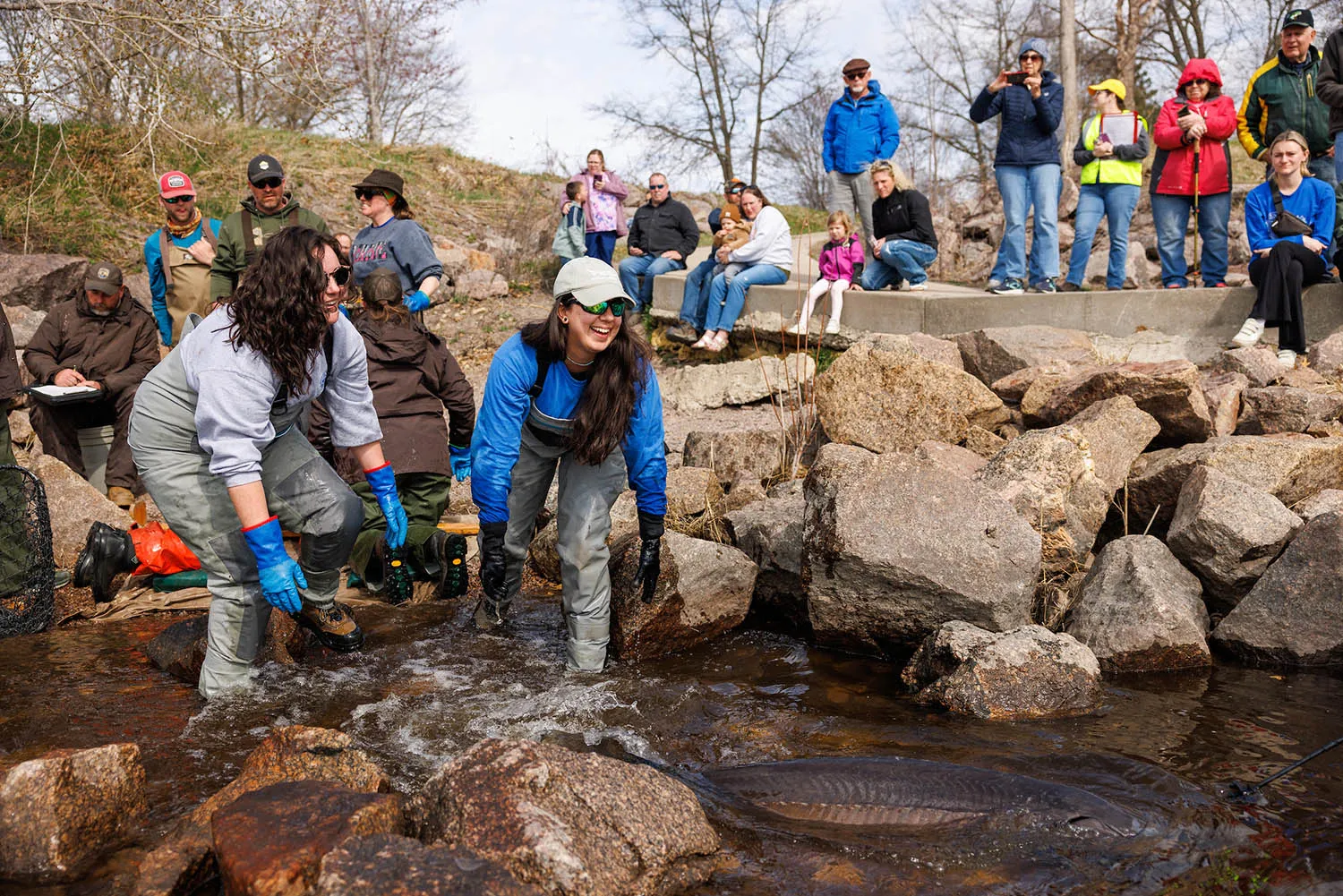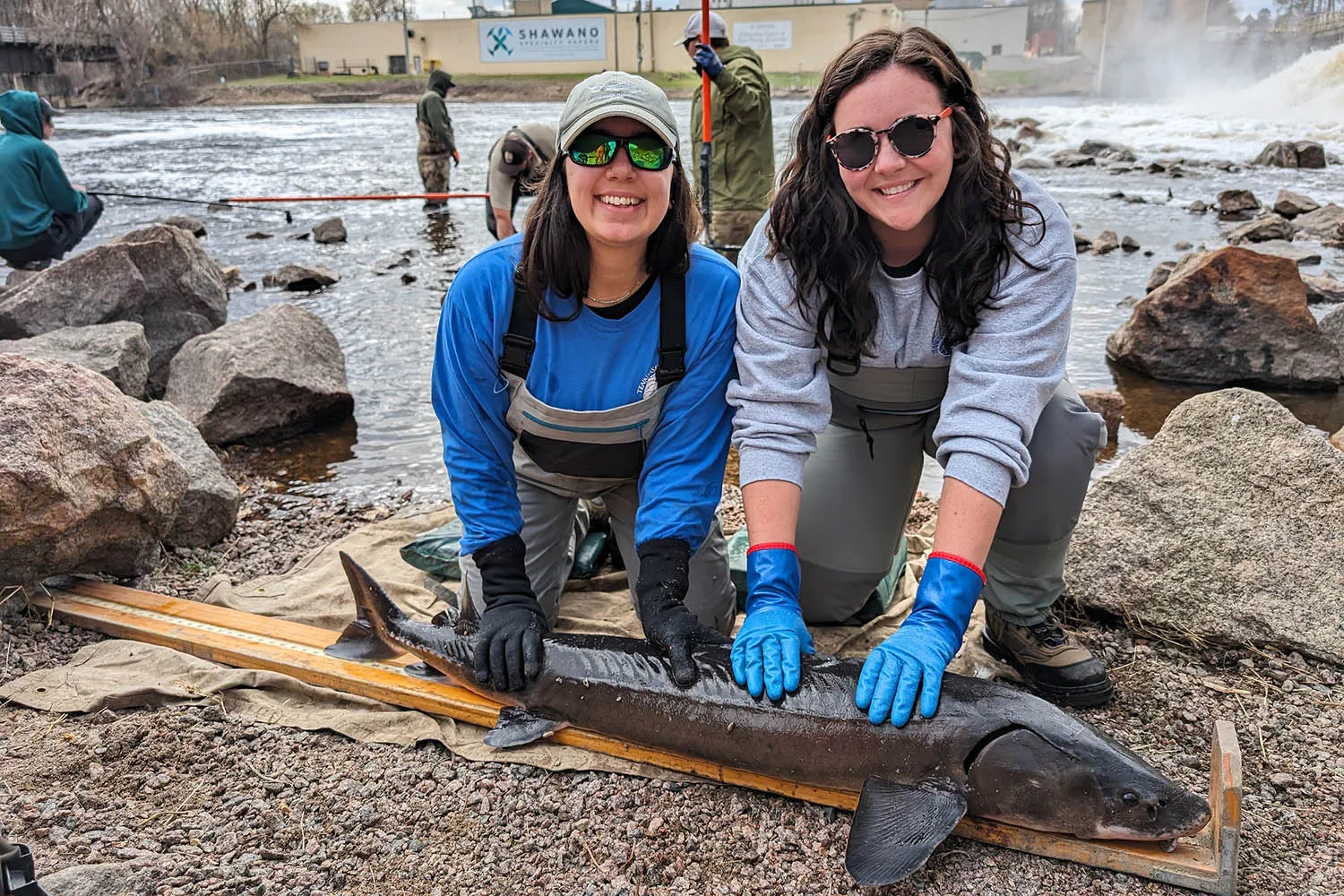Chattanooga, Tenn. (May 2, 2024) – Just across from the iconic peaks of the Tennessee Aquarium on the shore of the Tennessee River, a group of scientists with the Tennessee Aquarium Conservation Institute gathered Thursday to restore a primordial fish to the state’s primary waterway.
One by one, they carefully navigated down a boat ramp at Coolidge Park before gently releasing juvenile Lake Sturgeon, each just under a foot in length, into the river’s shallows. These 50 sturgeon were the final youngsters yet to be reintroduced from a class of hundreds of sturgeon fry that arrived at the Conservation Institute’s freshwater field station last summer. Their introduction to the Tennessee River represented the latest milestone of a decades-long conservation effort to restore this state-endangered fish.
Despite reclaiming their one-time home in the waters of the Volunteer State, these newfound Tennesseans began life some 850 miles north of Chattanooga.
Two weeks ago, a team of about a dozen biologists watched under gray skies as scores of wild Lake Sturgeon gathered among the rocks and fast-flowing water in the shallows of the Wolf River in Wisconsin. Piled atop one another near the shore, these huge fish — many five to six feet long — had made their way upriver to the base of a dam in the rural town of Shawano to spawn.
“If you look into the water, you can see all the sturgeon tails kind of sticking up,” says Tennessee Aquarium Reintroduction Biologist II Sarah Kate Bailey. “You can see the sturgeon stacking up together and swimming, splashing the water around. That is a sign that they are spawning.”
Prompted by rising water temperatures and a lengthening daylight period, the sturgeon will gather each spring by the hundreds along shorelines in this location and in other tributaries of the Fox River, which connects to Lake Michigan through Green Bay.
The gathered biologists included representatives from the Tennessee Aquarium Conservation Institute, the Wisconsin Department of Natural Resources (WDNR) and the U.S. Fish & Wildlife Service (USFWS). Although the Aquarium’s presence in Shawano is a rare occurrence, scientists and wildlife managers from these other agencies travel here annually to collect and fertilize eggs from the river’s healthy population of Lake Sturgeon.
On this occasion, a team from USFWS’ Warm Springs National Fish Hatchery in Warm Springs, Georgia, gathered about 150,000 eggs destined to be hatched out and released into locations where Lake Sturgeon populations are struggling.
USFWS fish biologists then ferried these sturgeon-in-waiting more than 1,200 miles south to the Peach State, where they’ll spend about six weeks hatching and going through the early stages of their development. Later this spring, many of these baby sturgeon will be delivered to the Tennessee Aquarium Conservation Institute, where they’ll spend the next few months growing robust enough to survive after reintroduction to the Tennessee River.
“I am so incredibly proud that our population is healthy enough that we’re actually able to help reintroduce populations to areas like Tennessee and Georgia,” says WDNR Fisheries Biologist Margaret Stadig. “The fact that we can play even the smallest of parts in that is just absolutely awe-inspiring.”
Stadig’s team serves as the frontline in the collection process in Wisconsin, dipping their nets to remove sturgeon from the shallows. It isn’t an easy task wrangling such enormous fish across slippery river stones, and safely getting the fish to shore is a group effort.
“Back at the Conservation Institute we work with these fish when they’re really tiny,” Bailey says. “A big sturgeon to us is maybe a foot long, whereas out here we’re regularly catching fish that are five or six feet long. It’s really amazing to see how large these sturgeon grow and what our populations in Tennessee may look like someday.”
This daunting undertaking is the culmination of a 24-year effort to restore Lake Sturgeon to the species’ erstwhile home in the Tennessee and Cumberland rivers.
By the 1970s, damming, overfishing and poor water quality led to the extirpation (aka local extinction) of Lake Sturgeon in the Tennessee River. In the decades that followed, however, passage of the Clean Water Act of 1972, new fisheries management practices and improvements to river management led to a general improvement to water quality in the Tennessee and other waterways.
In the early ’90s, conditions in the river once again were favorable enough to support Lake Sturgeon, which led the Aquarium and partnering organizations to form the Lake Sturgeon Working Group in 1998. The Working Group consists of more than a dozen conservation science organizations, universities and government agencies whose goal is to see this river giant returned to its ancestral waters.
To create new generations of Lake Sturgeon, however, scientists first needed the help of a healthy wild population. Fortunately, despite the species’ troubles farther south, they were thriving in the northern parts of their range in places like the Wolf River.
The first sturgeon hatched from these northern donors were returned to the Tennessee River in 2000. To date, the Lake Sturgeon Working Group has introduced more than 330,000 Lake Sturgeon into the Tennessee and Cumberland rivers.
None of this would be possible without the partnerships between state and federal agencies and nonprofits like the Conservation Institute, Stadig says.
“Our partners are here throughout every step of the process,” she says. “This is a huge program that spans across the southeast and up here into Wisconsin.”
The residents of Shawano and the surrounding communities are also partners – albeit unofficial ones – in that process, thanks to their dedication to preserving the aquatic environments these sturgeon rely on to spawn every year.
“It’s been really cool to come out here and see that the sturgeon is ingrained in the culture here in Shawano, and the surrounding areas,” says Aquarium Watershed Coordinator Helaina Gomez. “The community members come out and watch the sturgeon spawning. They put statues everywhere of the sturgeon.”
This mascotization of the sturgeon is best exemplified in the Sturgeon Guard, a volunteer program comprised of concerned residents that partners with WDNR. Members of the Guard serve as ambassadors and stand watch over the spawning sturgeon every year, helping to keep them safe and inform the public about the importance of these native fish.


Gomez hopes that enthusiasm will eventually catch hold in Tennessee where Lake Sturgeon populations have been buoyed by two decades of consistent reintroductions. Though the restoration project has been ongoing for 24 years, the very first sturgeon released by the Working Group are only now reaching the age when they could begin spawning in the wild.
Getting to work hands-on at the beginning of a process that takes these fish across five states was particularly special for Gomez.
“I feel like we talk often about how large sturgeon get and the massive size of them, but to actually put my hands on one and see them in their natural environment doing these spawning behaviors, piling up on top of one another, I was pretty speechless,” she says. “It puts into context the itty bitty sturgeon that we get in Tennessee, and they’ve got a long life ahead of them after they leave our care.”
